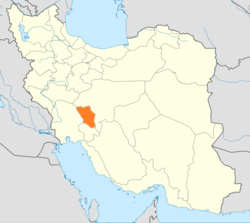Chaharmahal and Bakhtiari Province
| Chahar Mahaal and Bakhtiari Province استان چهارمحال و بختیاری | |
|---|---|
| Province | |
 Location of Chahar Mahaal and Bakhtiari within Iran | |
| Coordinates: 32°19′39″N 50°51′17″E / 32.3275°N 50.8546°ECoordinates: 32°19′39″N 50°51′17″E / 32.3275°N 50.8546°E | |
| Country |
|
| Region | Region 2 [1] |
| Capital | Shahrekord |
| Counties | 7 |
| Government | |
| • Governor | Qasem Soleimani Dashtaki |
| Area | |
| • Total | 16,332 km2 (6,306 sq mi) |
| Population [2] | |
| • Total | 895,263 |
| • Density | 55/km2 (140/sq mi) |
| Time zone | IRST (UTC+03:30) |
| • Summer (DST) | IRST (UTC+04:30) |
| Main language(s) |
Bakhtiari Lurish Persian |
Chaharmahal and Bakhtiari Province (Persian: استان چهارمحال و بختیاری, Ostān-e Chahār-Mahāl-o Bakhtiyārī ) is one of the 31 provinces of Iran. It lies in the southwestern part of the country. Its capital is Shahrekord.
The province was put as part of Region 2 upon the division of the provinces into 5 regions solely for coordination and development purposes on June 22nd, 2014.[3]
It has an area of 16,332 square kilometers, and had a population of 895,263 in 2011.[2]
People and culture
Ethnic composition of Chaharmahal and Bakhtiari
The history of the province is tied to that of the Bakhtiari tribe. The Bakhtiari tribe can be divided into two sub-tribes, Haft Lang and Chahar Lang with various territorial affiliations and they are the main speakers of Lurish language. As the name of the province dictates with the combining grammatical feature of "-o-" which is Persian for "and"; the other group of peoples in this ancient province are the Chahar Mahali's. These peoples and the Lur's live side by side and share almost similar customs. Very slight differences exist between them but most are almost unnoticeable. However there is often quite a bit of intermixing of the peoples through marriage. The cities of Shahrekord, Broujen, Ben, Naafch and Saman fall in the Chahar Mahali area of the province and are generally not inhabited by Lurs. The Bakhtiari territories at times have also come under Isfahan and Khuzestan province.
The people of this province have a history of having a simple living and being a capable people who are determined and effective warriors and fighters whenever circumstances made it necessary. They have gained such a reputation as being excellent, if not the best, horsemen in Iran. The people of this province, while having the more common Pahlevani wrestling/combat style of the deep rooted traditional Zurkhane, which exists everywhere in all provinces, also have their own style of wrestling/unarmed combat as well (as do other provinces). The style is called Jangi (Jang means War and hence Jangi "war'ish" or "war like").
The province has various unique traditions and rituals relative to the 'tribal' lifestyles. Special forms of music, dance, and clothing are noteworthy.
Administrative divisions
Counties (Shahrestans)
| Map | Shahrestan (≈County) | Bakhsh (≈District) | District Center |
|---|---|---|---|
| Ardal | Central | Ardal | |
| Miankooh | Sarkhun | ||
| Boroojen | Central | Boroojen | |
| Boldaji | Boldaji | ||
| Gandoman | Gandoman | ||
| Farsan | Central | Farsan | |
| Koohrang | Central | Chelgerd | |
| Bazaft | Chaman-Goli | ||
| Kiar | Central | Shalamzar | |
| Naghan | Naghan | ||
| Lordegan | Central | Lordegan | |
| Falard | Mal-e Khalifeh | ||
| Khanmirza | Aluni | ||
| Manj | Manj | ||
| Shahr-e Kord | Central | Shahr-e Kord | |
| Ben | Ben | ||
| Laran | Soureshjan | ||
| Saman | Saman |
Cities and towns
- Shahrekord
- Shahrekian
- Hafshejan
- Borujen
- Lordegan
- Farsan
- Ardal
- Dashtak
- Kaj
- Farrokhshahr
- Naafch
- Saman
- Juneghan
- Ben
- Gandoman
- Boldaji
- Faradonbeh
Economy
The province is mainly active in the agriculture sector. Most of the industrial sector is clustered around the center of the province.
The province has the potential to become a vibrant tourist attraction because of its natural resources.
Colleges and universities
- Islamic Azad University, Shahrekord Branch, (website)
- Shahrekord University
- Islamic Azad University of Borujen
- Shahrekord University of Medical Sciences
References
External links
| Wikimedia Commons has media related to Chaharmahal and Bakhtiari Province. |
- Official website of Chahar Mahaal and Bakhtiari Governorship
- Provincial Bureau for Budget, Planning, and Management (سازمان مدیریت و برنامه ریزی)
- Shahrekord Municipality (شهرداری شهرکرد)
- Provincial Bureau for Telecommunications (شرکت مخابرات)
- Provincial Bureau of Industries and Mines
- (Persian) Provincial Department of Transportation (سازمان حمل و نقل و پایانهها)
- (Persian) Provincial Bureau of Economics and Finance Affairs (سازمان امور اقتصادی و دارائی)
- (Persian) Provincial Department of Education (سازمان آموزش و پرورش)
- Provincial Bureau of Taavon (اداره کل تعاون)
- Provincial Department of Utilities (سازمان آب وفاضلاب روستایی)
- Shahrekord Central Post Office (اداره کل پست)
- Provincial Department of Medical Insurance (بیمه خدمات درمانی)
- (Persian) Provincial Bureau of Agricultural Jihad (سازمان جهاد کشاورزی)
- (Persian) Provincial Welfare Organization (سازمان بهزیستی)
- (Persian) Provincial Department of Social Security (اداره کل تامین اجتماعی)
- (Persian) Provincial Meteorological Service (اداره کل هواشناسی)
- Chahar Mahal va Bakhtiyari Attractions
 |
Isfahan Province |  | ||
| Khuzestan Province | |
|||
| ||||
| | ||||
| Kohgiluyeh and Boyer-Ahmad Province |
| ||||||||||||||||||||||||||||||||||||||||||||||
| |||||||||||||


